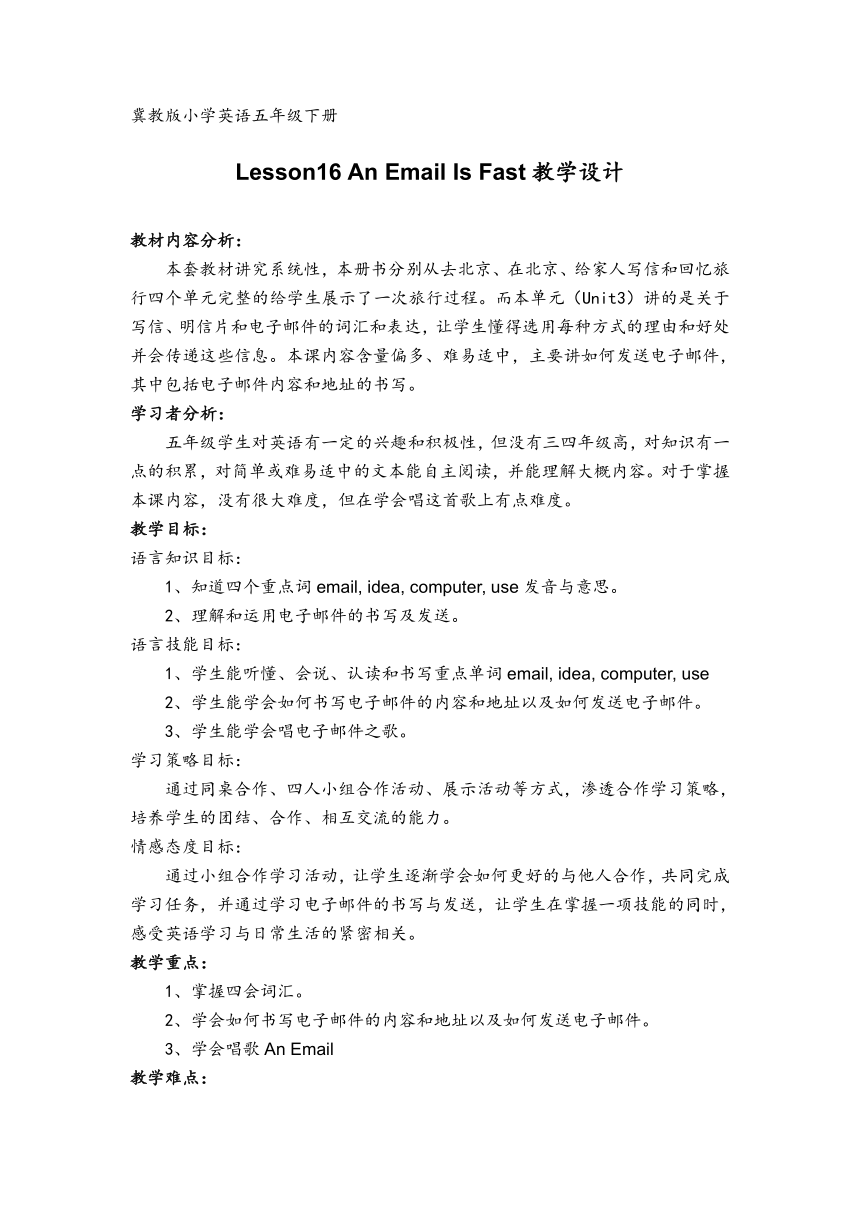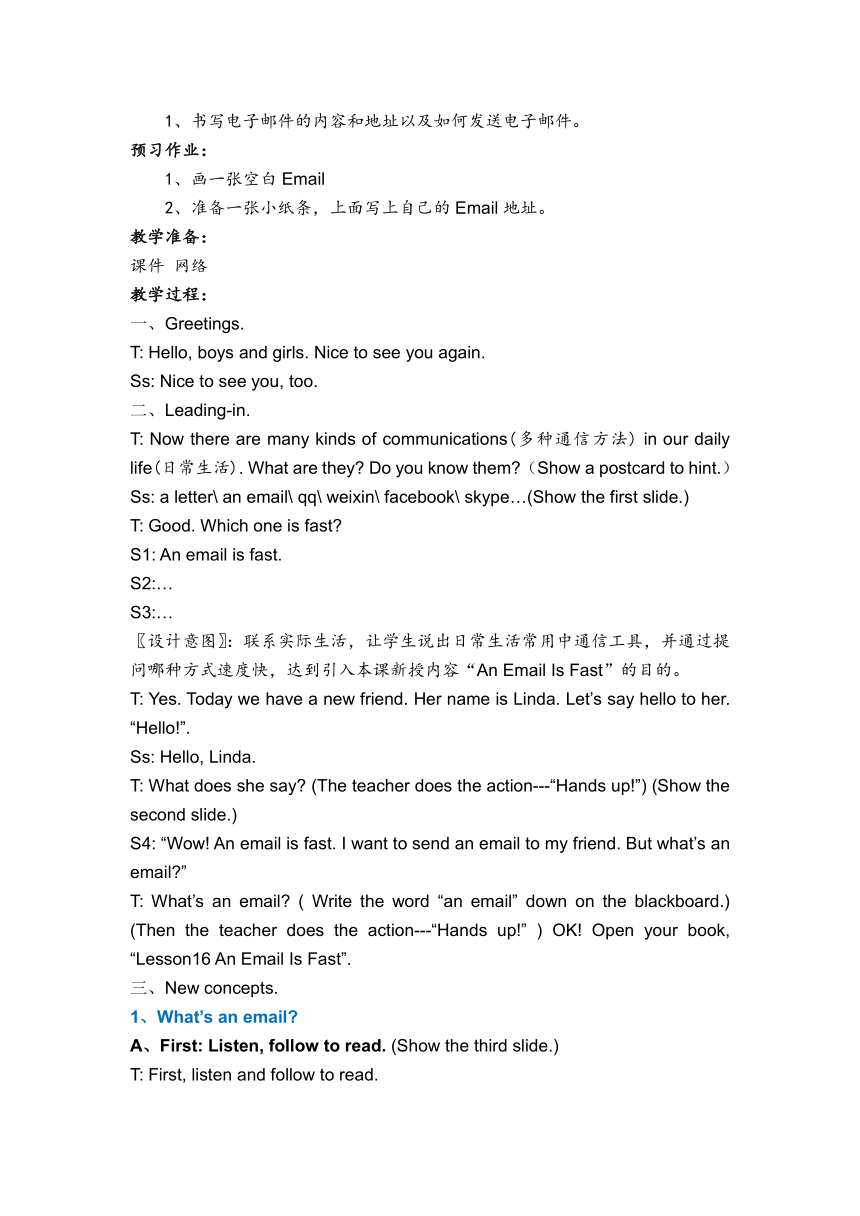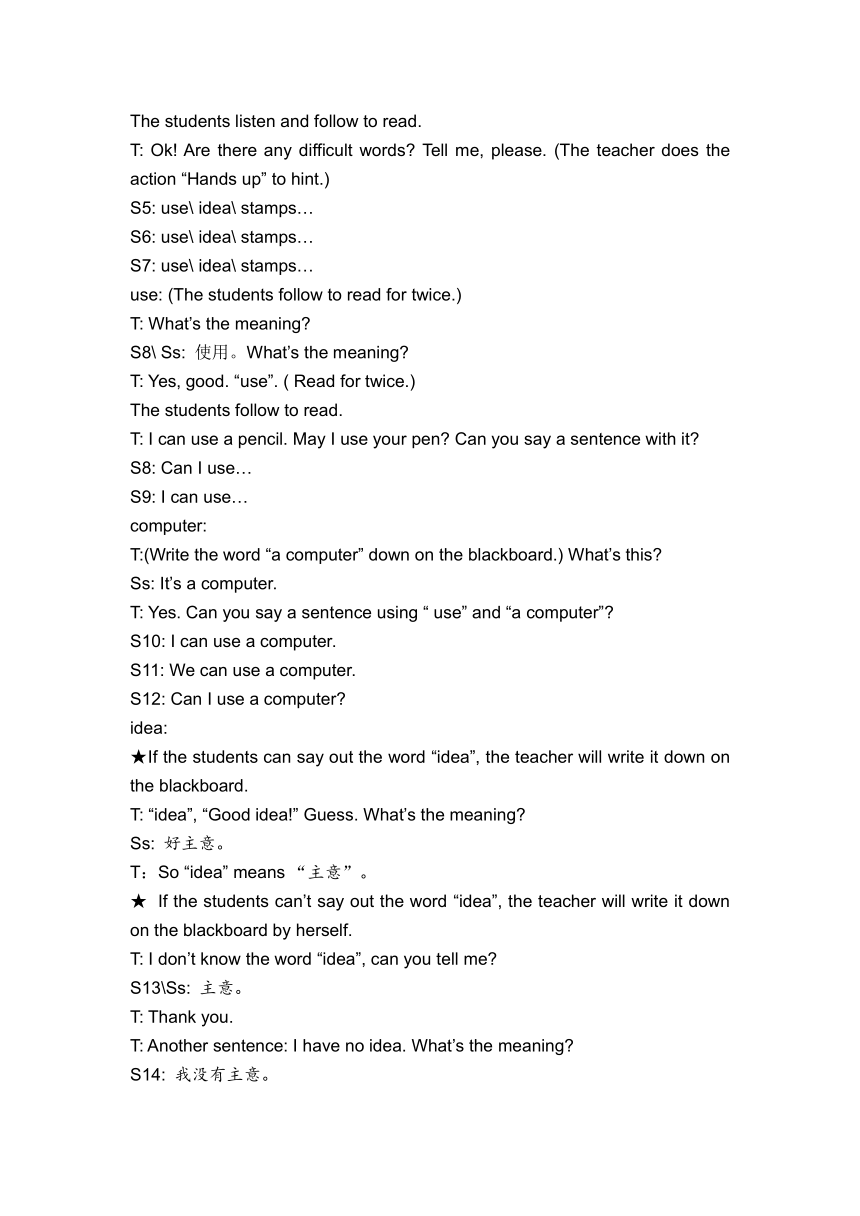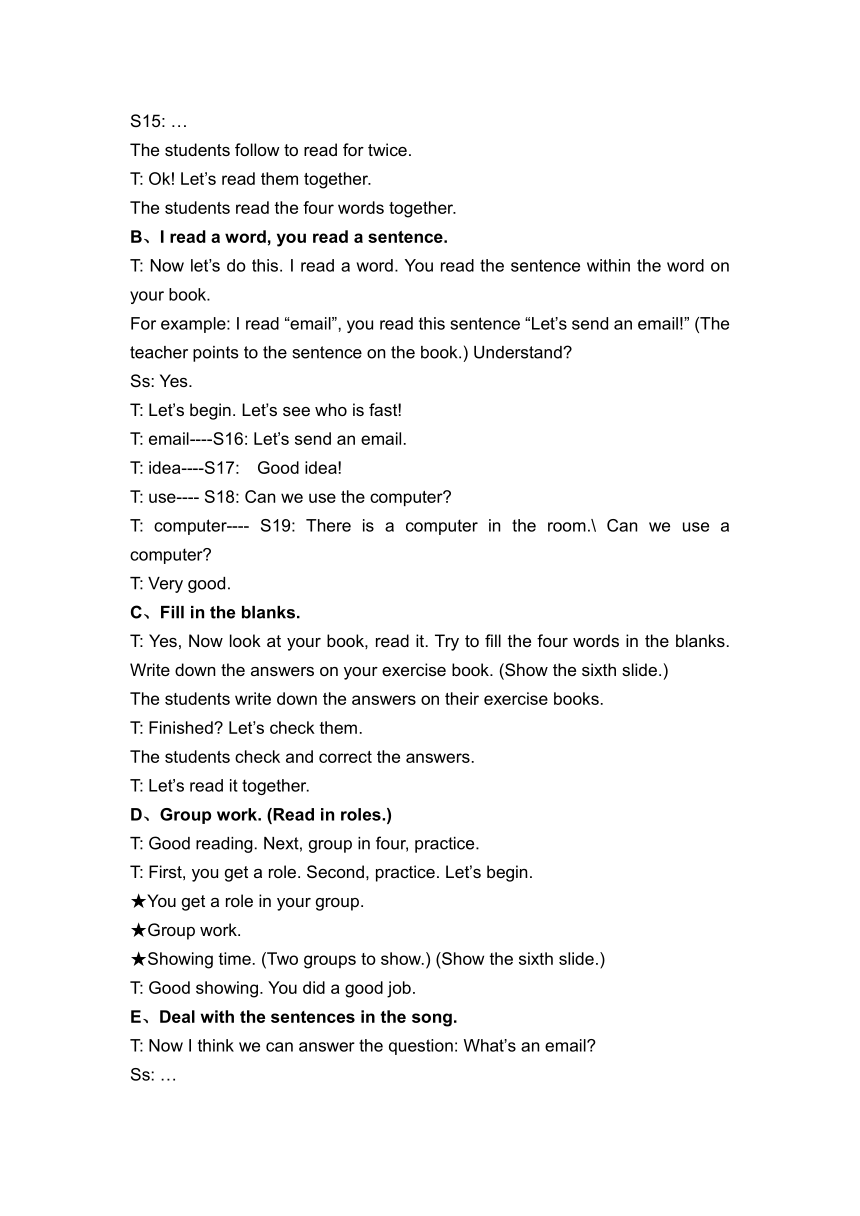Unit 3 Lesson 16 An Email Is Fast 教案
文档属性
| 名称 | Unit 3 Lesson 16 An Email Is Fast 教案 |  | |
| 格式 | doc | ||
| 文件大小 | 59.5KB | ||
| 资源类型 | 教案 | ||
| 版本资源 | 冀教版(三年级起点) | ||
| 科目 | 英语 | ||
| 更新时间 | 2021-06-16 21:27:13 | ||
图片预览




文档简介
冀教版小学英语五年级下册
Lesson16
An
Email
Is
Fast教学设计
教材内容分析:
本套教材讲究系统性,本册书分别从去北京、在北京、给家人写信和回忆旅行四个单元完整的给学生展示了一次旅行过程。而本单元(Unit3)讲的是关于写信、明信片和电子邮件的词汇和表达,让学生懂得选用每种方式的理由和好处并会传递这些信息。本课内容含量偏多、难易适中,主要讲如何发送电子邮件,其中包括电子邮件内容和地址的书写。
学习者分析:
五年级学生对英语有一定的兴趣和积极性,但没有三四年级高,对知识有一点的积累,对简单或难易适中的文本能自主阅读,并能理解大概内容。对于掌握本课内容,没有很大难度,但在学会唱这首歌上有点难度。
教学目标:
语言知识目标:
1、知道四个重点词email,
idea,
computer,
use发音与意思。
2、理解和运用电子邮件的书写及发送。
语言技能目标:
1、学生能听懂、会说、认读和书写重点单词email,
idea,
computer,
use
2、学生能学会如何书写电子邮件的内容和地址以及如何发送电子邮件。
3、学生能学会唱电子邮件之歌。
学习策略目标:
通过同桌合作、四人小组合作活动、展示活动等方式,渗透合作学习策略,培养学生的团结、合作、相互交流的能力。
情感态度目标:
通过小组合作学习活动,让学生逐渐学会如何更好的与他人合作,共同完成学习任务,并通过学习电子邮件的书写与发送,让学生在掌握一项技能的同时,感受英语学习与日常生活的紧密相关。
教学重点:
1、掌握四会词汇。
2、学会如何书写电子邮件的内容和地址以及如何发送电子邮件。
3、学会唱歌An
Email
教学难点:
1、书写电子邮件的内容和地址以及如何发送电子邮件。
预习作业:
1、画一张空白Email
2、准备一张小纸条,上面写上自己的Email地址。
教学准备:
课件
网络
教学过程:
一、Greetings.
T:
Hello,
boys
and
girls.
Nice
to
see
you
again.
Ss:
Nice
to
see
you,
too.
二、Leading-in.
T:
Now
there
are
many
kinds
of
communications(多种通信方法)
in
our
daily
life(日常生活).
What
are
they?
Do
you
know
them?(Show
a
postcard
to
hint.)
Ss:
a
letter\
an
email\
qq\
weixin\
facebook\
skype…(Show
the
first
slide.)
T:
Good.
Which
one
is
fast?
S1:
An
email
is
fast.
S2:…
S3:…
〖设计意图〗:联系实际生活,让学生说出日常生活常用中通信工具,并通过提问哪种方式速度快,达到引入本课新授内容“An
Email
Is
Fast”的目的。
T:
Yes.
Today
we
have
a
new
friend.
Her
name
is
Linda.
Let’s
say
hello
to
her.
“Hello!”.
Ss:
Hello,
Linda.
T:
What
does
she
say?
(The
teacher
does
the
action---“Hands
up!”)
(Show
the
second
slide.)
S4:
“Wow!
An
email
is
fast.
I
want
to
send
an
email
to
my
friend.
But
what’s
an
email?”
T:
What’s
an
email?
(
Write
the
word
“an
email”
down
on
the
blackboard.)
(Then
the
teacher
does
the
action---“Hands
up!”
)
OK!
Open
your
book,
“Lesson16
An
Email
Is
Fast”.
三、New
concepts.
1、What’s
an
email?
A、First:
Listen,
follow
to
read.
(Show
the
third
slide.)
T:
First,
listen
and
follow
to
read.
The
students
listen
and
follow
to
read.
T:
Ok!
Are
there
any
difficult
words?
Tell
me,
please.
(The
teacher
does
the
action
“Hands
up”
to
hint.)
S5:
use\
idea\
stamps…
S6:
use\
idea\
stamps…
S7:
use\
idea\
stamps…
use:
(The
students
follow
to
read
for
twice.)
T:
What’s
the
meaning?
S8\
Ss:
使用。What’s
the
meaning?
T:
Yes,
good.
“use”.
(
Read
for
twice.)
The
students
follow
to
read.
T:
I
can
use
a
pencil.
May
I
use
your
pen?
Can
you
say
a
sentence
with
it?
S8:
Can
I
use
S9:
I
can
use
computer:
T:(Write
the
word
揳
computer
down
on
the
blackboard.)
What抯
this?
Ss:
It抯
a
computer.
T:
Yes.
Can
you
say
a
sentence
using
use
and
揳
computer?
S10:
I
can
use
a
computer.
S11:
We
can
use
a
computer.
S12:
Can
I
use
a
computer?
idea:
★If
the
students
can
say
out
the
word
“idea”,
the
teacher
will
write
it
down
on
the
blackboard.
T:
“idea”,
“Good
idea!”
Guess.
What’s
the
meaning?
Ss:
好主意。
T:So
“idea”
means
“主意”。
★
If
the
students
can’t
say
out
the
word
“idea”,
the
teacher
will
write
it
down
on
the
blackboard
by
herself.
T:
I
don’t
know
the
word
“idea”,
can
you
tell
me?
S13\Ss:
主意。
T:
Thank
you.
T:
Another
sentence:
I
have
no
idea.
What’s
the
meaning?
S14:
我没有主意。
S15:
…
The
students
follow
to
read
for
twice.
T:
Ok!
Let’s
read
them
together.
The
students
read
the
four
words
together.
B、I
read
a
word,
you
read
a
sentence.
T:
Now
let’s
do
this.
I
read
a
word.
You
read
the
sentence
within
the
word
on
your
book.
For
example:
I
read
“email”,
you
read
this
sentence
“Let’s
send
an
email!”
(The
teacher
points
to
the
sentence
on
the
book.)
Understand?
Ss:
Yes.
T:
Let抯
begin.
Let抯
see
who
is
fast!
T:
email----S16:
Let抯
send
an
email.
T:
idea----S17:
Good
idea!
T:
use----
S18:
Can
we
use
the
computer?
T:
computer----
S19:
There
is
a
computer
in
the
room.\
Can
we
use
a
computer?
T:
Very
good.
C、Fill
in
the
blanks.
T:
Yes,
Now
look
at
your
book,
read
it.
Try
to
fill
the
four
words
in
the
blanks.
Write
down
the
answers
on
your
exercise
book.
(Show
the
sixth
slide.)
The
students
write
down
the
answers
on
their
exercise
books.
T:
Finished?
Let’s
check
them.
The
students
check
and
correct
the
answers.
T:
Let’s
read
it
together.
D、Group
work.
(Read
in
roles.)
T:
Good
reading.
Next,
group
in
four,
practice.
T:
First,
you
get
a
role.
Second,
practice.
Let’s
begin.
★You
get
a
role
in
your
group.
★Group
work.
★Showing
time.
(Two
groups
to
show.)
(Show
the
sixth
slide.)
T:
Good
showing.
You
did
a
good
job.
E、Deal
with
the
sentences
in
the
song.
T:
Now
I
think
we
can
answer
the
question:
What’s
an
email?
Ss:
…
The
teacher
points
to
the
slide
to
hint
how
to
answer.
Change
the
sentences
to
the
next
sentences.
An
email
is
fast,
No
stamp,
no
pen.
My
computer
sends
it
all,
To
you,
my
friend.
T:
Oh,
it’s
like
the
song
on
our
book.
Yes?
Ss:
Yes.
T:
Follow
me
to
read,
please.
The
students
follow
to
read.
T:
Ok!Now
what
does
Linda
say?
What
happens
to
her?
(Show
the
sixth
slide.)
S22
read
what
Linda
says.
T:
Can
you
send
an
email?
Ss:
Yes.
T:
Ok,
let’s
help
her.
〖设计意图〗:通过Linda情境,需要帮助她解决另一个问题,自然的引出下一部分的新授内容。
2、How
to
send
an
email
A:
Listen
and
understand.
T:
First,
listen
and
understand
the
three
words.
The
students
listen
and
try
to
say
out
the
meanings.
S23:
to—给……
S24:from---来自
S25:
subject---主题
S26:
content---内容
T:
Right.
B、Try
to
write
an
email.
★the
address:
1、How
to
write
and
read
the
address.
T:
Look
here,
please.
First,
we
write
the
address.
(
The
teacher
points
to
the
blackboard
and
write
down
the
address.)
T:
Do
you
know
“@”?
Let’s
see!
(Show
the
eighth
slide.)
The
teacher
teaches
the
students
how
to
pronounce
the
address.
The
students
follow
to
read.
★the
content:
T:
Second,
write
the
content.
(The
teacher
points
to
the
paper.)
Look
at
your
book,
try
to
order
them.
The
students
read
the
books
and
order
the
paper.
The
teacher
and
the
students
say
together:
T:
First,
write
the
name
who
you
send
to.
(stick)
Ss:
Dear
Dad.
T:
Second,
write
the
content.
(stick)
Ss:
…
T:
Third,
write
down
your
name.
(stick)
Ss:
…
T:
Let’s
read
together.
The
students
read
the
content
together.
(Show
the
slide---Part3)
T:
We
can
write
an
email
in
different
ways.
(show
the
replacing.)Read
and
number.
The
students
do
it.
Then
check
the
answers
together.
(
When
the
teacher
checks
the
answers,
she
replaces
the
content.)
〖设计意图〗:通过在黑板上清晰的展示邮件内容的构成,让学生掌握邮件的书写形式。通过做题,进一步巩固学生对内容书写形式的掌握,并明白内容的每一部分都可以用不同的方法来表示,不是一成不变的。
T:
Good
work.
Now
I
send
an
email
online.
You
can
watch
it.
The
teacher
shows,
the
students
watches
carefully.
〖设计意图〗:通过真实的在网上发送一封邮件,在让学生熟悉环节的过程中,还让学生感到,英语和日常生活的紧密相关。
T:
Can
you
write
an
email
now?
Ss:
Yes.
T:
Let’s
write
an
email
to
your
friend.
四、Practice.
A、Pair
work.
Ask
and
answer.
T:
You
can
ask
your
partner’s
address.
(Show
the
question:
What’s
your
address?)
(Show
the
tenth
slide.)
The
students
ask
and
answer.
〖设计意图〗:通过对电子邮件地址的问答,巩固学生对电子邮件地址的读法,与此同时,得到对方的邮件地址,为下面写邮件打下基础。
B、
Write
an
email.
(Show
the
tenth
slide.)
★Write
the
email.
★Read
the
email.
★Show
the
email.
T:
Wonderful!
〖设计意图〗:通过写邮件环节,设置写邮件、发邮件情境,考查学生对所学内容的掌握程度,对所学内容提供展示的机会,通过同桌两个互发邮件并读出内容,促进同桌的交流。
五、Let’s
sing.
A、Deal
with
the
song.
T:
Ok.
Now
you
can
write
an
email.
Let’s
tell
Linda
how
to
send
it.
(Lead
the
students
read
following
the
teacher.)
First
write
the
address,
and
who
I
send
to.
Second,
write
the
content.
Third,
don’t
forget
to
write
my
name.
(Point
to
the
song,
then
circle
the
name.)
(Show
the
song.)
T:Watch
them.
They
are
the
_______.
Ss:
The
same.
T:
So
this
is
our
song.
This
is
what
an
email
is.
(Point
to
the
first
paragraph.
)
This
is
how
to
send
an
email.
(Point
to
the
second
paragraph.)
〖设计意图〗:通过总结如何发送电子邮件的过程,成功使歌词和教学内容自然的融合在一起。
B:
Sing
the
song.
T:
Let’s
sing
it
together,
ok?
Ss:
Yes.
First,
just
listen.
The
students
listen
to
the
song.
T:
Follow
me
to
read.
The
students
follow
to
read.
T:
This
time,
listen
and
try
to
sing
together.
〖设计意图〗:因为把歌词放在新授中处理了一下,所以现在学生感到很容易,通过听一遍、跟老师唱、齐唱的方式,达到让学生会唱歌的目的。
T:
Linda
is
very
happy.
What
does
Linda
say?
Let’s
look!
Read
together,
ok?
Ss:
Ok.
The
students
read
together.
〖设计意图〗:通过Linda情境,感谢同学们的帮助,让学生感受成就感,也让某些同学感觉到了和Linda
一样的存在感。
六、Homework.
T:
You
can
sing
the
song
after
class.
Let’s
know
more
about
the
emailboxes
and
the
addresses.
(Show
the
sixteenth,
the
seventeenth
and
the
eighteenth
slides.)
〖设计意图〗:作为扩展内容出现,让学生对电子邮件有更进一步的认识,也为作业打下基础,尝试学着申请一个新邮箱。
Homework
for
today:
You
can
learn
to
register(注册)
a
new
address.
2、Write
and
send
an
email
to
your
English
teacher.
(80874816@)
〖设计意图〗:给老师发送邮件作业,给学生提供锻炼的机会,锻炼书写地址和内容,发送给老师后,老师还可以很方便的检查作业,在课堂上给出合适的评价。
教学反思
五年级学生对英语有一定的兴趣和积极性,但没有三四年级高,对知识有一点的积累,对简单或难易适中的文本能自主阅读,并能理解大概内容。对于掌握本课内容,没有很大难度,但在学会唱这首歌上有一定难度。
1.
本节课采用任务型教学,利用多媒体课件突出重点,突破难点,使教学内容形象生动有趣,学生易于接受;根据学生的年龄特征采用多种游戏活动,激发兴趣,激活思维。为了让学生掌握这些技能,我设计了一些子任务(while
task),
试着发送电子邮件(学会运用句型:Let’s
send
an
email
to
dad.
Click
on
‘email’.
Click
on
‘write’.
Write
your
message.)运用英语进行交流,学以致用。,这些任务型活动由易到难,让每一个孩子都有用英语表达自己的机会,得到老师、同学的赞许,也获得了自我的肯定。
2.
教学中的衔接是很重要的,因此,我在每一步的教学设计中都巧妙的运用各种方法贯穿始末,从而使整个课堂学习更加自如流畅.
3.
在单词教学中,我用两个不同的铺垫,层层引申,不仅学习了所有单词和句型,而且大大提高了学生的学习积极性.
4.
小学英语教学评价的主要目的是刺激学生的学习兴趣和积极性,形成继续学习的动力。因此。在教学过程中,教师多采用表扬和鼓励性的语言,对学生进行积极、具体、有效的评价。
本课我设定了三个目标。第一个目标是对电子邮件的了解。第二是学生掌握书写电子邮件的形式,并学会怎样发送电子邮件。第三个目标是重点单词、句型的学习。通过这节课,我引领学生走到真实的情境中,紧紧抓住学生,让学生积极参与到课堂中来,通过各种句型操练与表演,大大提高了学生的语言综合运用能力,有效地培养了英语思维模式,并对学生学习策略的培养打下了基础。
Lesson16
An
Is
Fast教学设计
教材内容分析:
本套教材讲究系统性,本册书分别从去北京、在北京、给家人写信和回忆旅行四个单元完整的给学生展示了一次旅行过程。而本单元(Unit3)讲的是关于写信、明信片和电子邮件的词汇和表达,让学生懂得选用每种方式的理由和好处并会传递这些信息。本课内容含量偏多、难易适中,主要讲如何发送电子邮件,其中包括电子邮件内容和地址的书写。
学习者分析:
五年级学生对英语有一定的兴趣和积极性,但没有三四年级高,对知识有一点的积累,对简单或难易适中的文本能自主阅读,并能理解大概内容。对于掌握本课内容,没有很大难度,但在学会唱这首歌上有点难度。
教学目标:
语言知识目标:
1、知道四个重点词email,
idea,
computer,
use发音与意思。
2、理解和运用电子邮件的书写及发送。
语言技能目标:
1、学生能听懂、会说、认读和书写重点单词email,
idea,
computer,
use
2、学生能学会如何书写电子邮件的内容和地址以及如何发送电子邮件。
3、学生能学会唱电子邮件之歌。
学习策略目标:
通过同桌合作、四人小组合作活动、展示活动等方式,渗透合作学习策略,培养学生的团结、合作、相互交流的能力。
情感态度目标:
通过小组合作学习活动,让学生逐渐学会如何更好的与他人合作,共同完成学习任务,并通过学习电子邮件的书写与发送,让学生在掌握一项技能的同时,感受英语学习与日常生活的紧密相关。
教学重点:
1、掌握四会词汇。
2、学会如何书写电子邮件的内容和地址以及如何发送电子邮件。
3、学会唱歌An
教学难点:
1、书写电子邮件的内容和地址以及如何发送电子邮件。
预习作业:
1、画一张空白Email
2、准备一张小纸条,上面写上自己的Email地址。
教学准备:
课件
网络
教学过程:
一、Greetings.
T:
Hello,
boys
and
girls.
Nice
to
see
you
again.
Ss:
Nice
to
see
you,
too.
二、Leading-in.
T:
Now
there
are
many
kinds
of
communications(多种通信方法)
in
our
daily
life(日常生活).
What
are
they?
Do
you
know
them?(Show
a
postcard
to
hint.)
Ss:
a
letter\
an
email\
qq\
weixin\
facebook\
skype…(Show
the
first
slide.)
T:
Good.
Which
one
is
fast?
S1:
An
is
fast.
S2:…
S3:…
〖设计意图〗:联系实际生活,让学生说出日常生活常用中通信工具,并通过提问哪种方式速度快,达到引入本课新授内容“An
Is
Fast”的目的。
T:
Yes.
Today
we
have
a
new
friend.
Her
name
is
Linda.
Let’s
say
hello
to
her.
“Hello!”.
Ss:
Hello,
Linda.
T:
What
does
she
say?
(The
teacher
does
the
action---“Hands
up!”)
(Show
the
second
slide.)
S4:
“Wow!
An
is
fast.
I
want
to
send
an
to
my
friend.
But
what’s
an
email?”
T:
What’s
an
email?
(
Write
the
word
“an
email”
down
on
the
blackboard.)
(Then
the
teacher
does
the
action---“Hands
up!”
)
OK!
Open
your
book,
“Lesson16
An
Is
Fast”.
三、New
concepts.
1、What’s
an
email?
A、First:
Listen,
follow
to
read.
(Show
the
third
slide.)
T:
First,
listen
and
follow
to
read.
The
students
listen
and
follow
to
read.
T:
Ok!
Are
there
any
difficult
words?
Tell
me,
please.
(The
teacher
does
the
action
“Hands
up”
to
hint.)
S5:
use\
idea\
stamps…
S6:
use\
idea\
stamps…
S7:
use\
idea\
stamps…
use:
(The
students
follow
to
read
for
twice.)
T:
What’s
the
meaning?
S8\
Ss:
使用。What’s
the
meaning?
T:
Yes,
good.
“use”.
(
Read
for
twice.)
The
students
follow
to
read.
T:
I
can
use
a
pencil.
May
I
use
your
pen?
Can
you
say
a
sentence
with
it?
S8:
Can
I
use
S9:
I
can
use
computer:
T:(Write
the
word
揳
computer
down
on
the
blackboard.)
What抯
this?
Ss:
It抯
a
computer.
T:
Yes.
Can
you
say
a
sentence
using
use
and
揳
computer?
S10:
I
can
use
a
computer.
S11:
We
can
use
a
computer.
S12:
Can
I
use
a
computer?
idea:
★If
the
students
can
say
out
the
word
“idea”,
the
teacher
will
write
it
down
on
the
blackboard.
T:
“idea”,
“Good
idea!”
Guess.
What’s
the
meaning?
Ss:
好主意。
T:So
“idea”
means
“主意”。
★
If
the
students
can’t
say
out
the
word
“idea”,
the
teacher
will
write
it
down
on
the
blackboard
by
herself.
T:
I
don’t
know
the
word
“idea”,
can
you
tell
me?
S13\Ss:
主意。
T:
Thank
you.
T:
Another
sentence:
I
have
no
idea.
What’s
the
meaning?
S14:
我没有主意。
S15:
…
The
students
follow
to
read
for
twice.
T:
Ok!
Let’s
read
them
together.
The
students
read
the
four
words
together.
B、I
read
a
word,
you
read
a
sentence.
T:
Now
let’s
do
this.
I
read
a
word.
You
read
the
sentence
within
the
word
on
your
book.
For
example:
I
read
“email”,
you
read
this
sentence
“Let’s
send
an
email!”
(The
teacher
points
to
the
sentence
on
the
book.)
Understand?
Ss:
Yes.
T:
Let抯
begin.
Let抯
see
who
is
fast!
T:
email----S16:
Let抯
send
an
email.
T:
idea----S17:
Good
idea!
T:
use----
S18:
Can
we
use
the
computer?
T:
computer----
S19:
There
is
a
computer
in
the
room.\
Can
we
use
a
computer?
T:
Very
good.
C、Fill
in
the
blanks.
T:
Yes,
Now
look
at
your
book,
read
it.
Try
to
fill
the
four
words
in
the
blanks.
Write
down
the
answers
on
your
exercise
book.
(Show
the
sixth
slide.)
The
students
write
down
the
answers
on
their
exercise
books.
T:
Finished?
Let’s
check
them.
The
students
check
and
correct
the
answers.
T:
Let’s
read
it
together.
D、Group
work.
(Read
in
roles.)
T:
Good
reading.
Next,
group
in
four,
practice.
T:
First,
you
get
a
role.
Second,
practice.
Let’s
begin.
★You
get
a
role
in
your
group.
★Group
work.
★Showing
time.
(Two
groups
to
show.)
(Show
the
sixth
slide.)
T:
Good
showing.
You
did
a
good
job.
E、Deal
with
the
sentences
in
the
song.
T:
Now
I
think
we
can
answer
the
question:
What’s
an
email?
Ss:
…
The
teacher
points
to
the
slide
to
hint
how
to
answer.
Change
the
sentences
to
the
next
sentences.
An
is
fast,
No
stamp,
no
pen.
My
computer
sends
it
all,
To
you,
my
friend.
T:
Oh,
it’s
like
the
song
on
our
book.
Yes?
Ss:
Yes.
T:
Follow
me
to
read,
please.
The
students
follow
to
read.
T:
Ok!Now
what
does
Linda
say?
What
happens
to
her?
(Show
the
sixth
slide.)
S22
read
what
Linda
says.
T:
Can
you
send
an
email?
Ss:
Yes.
T:
Ok,
let’s
help
her.
〖设计意图〗:通过Linda情境,需要帮助她解决另一个问题,自然的引出下一部分的新授内容。
2、How
to
send
an
A:
Listen
and
understand.
T:
First,
listen
and
understand
the
three
words.
The
students
listen
and
try
to
say
out
the
meanings.
S23:
to—给……
S24:from---来自
S25:
subject---主题
S26:
content---内容
T:
Right.
B、Try
to
write
an
email.
★the
address:
1、How
to
write
and
read
the
address.
T:
Look
here,
please.
First,
we
write
the
address.
(
The
teacher
points
to
the
blackboard
and
write
down
the
address.)
T:
Do
you
know
“@”?
Let’s
see!
(Show
the
eighth
slide.)
The
teacher
teaches
the
students
how
to
pronounce
the
address.
The
students
follow
to
read.
★the
content:
T:
Second,
write
the
content.
(The
teacher
points
to
the
paper.)
Look
at
your
book,
try
to
order
them.
The
students
read
the
books
and
order
the
paper.
The
teacher
and
the
students
say
together:
T:
First,
write
the
name
who
you
send
to.
(stick)
Ss:
Dear
Dad.
T:
Second,
write
the
content.
(stick)
Ss:
…
T:
Third,
write
down
your
name.
(stick)
Ss:
…
T:
Let’s
read
together.
The
students
read
the
content
together.
(Show
the
slide---Part3)
T:
We
can
write
an
in
different
ways.
(show
the
replacing.)Read
and
number.
The
students
do
it.
Then
check
the
answers
together.
(
When
the
teacher
checks
the
answers,
she
replaces
the
content.)
〖设计意图〗:通过在黑板上清晰的展示邮件内容的构成,让学生掌握邮件的书写形式。通过做题,进一步巩固学生对内容书写形式的掌握,并明白内容的每一部分都可以用不同的方法来表示,不是一成不变的。
T:
Good
work.
Now
I
send
an
online.
You
can
watch
it.
The
teacher
shows,
the
students
watches
carefully.
〖设计意图〗:通过真实的在网上发送一封邮件,在让学生熟悉环节的过程中,还让学生感到,英语和日常生活的紧密相关。
T:
Can
you
write
an
now?
Ss:
Yes.
T:
Let’s
write
an
to
your
friend.
四、Practice.
A、Pair
work.
Ask
and
answer.
T:
You
can
ask
your
partner’s
address.
(Show
the
question:
What’s
your
address?)
(Show
the
tenth
slide.)
The
students
ask
and
answer.
〖设计意图〗:通过对电子邮件地址的问答,巩固学生对电子邮件地址的读法,与此同时,得到对方的邮件地址,为下面写邮件打下基础。
B、
Write
an
email.
(Show
the
tenth
slide.)
★Write
the
email.
★Read
the
email.
★Show
the
email.
T:
Wonderful!
〖设计意图〗:通过写邮件环节,设置写邮件、发邮件情境,考查学生对所学内容的掌握程度,对所学内容提供展示的机会,通过同桌两个互发邮件并读出内容,促进同桌的交流。
五、Let’s
sing.
A、Deal
with
the
song.
T:
Ok.
Now
you
can
write
an
email.
Let’s
tell
Linda
how
to
send
it.
(Lead
the
students
read
following
the
teacher.)
First
write
the
address,
and
who
I
send
to.
Second,
write
the
content.
Third,
don’t
forget
to
write
my
name.
(Point
to
the
song,
then
circle
the
name.)
(Show
the
song.)
T:Watch
them.
They
are
the
_______.
Ss:
The
same.
T:
So
this
is
our
song.
This
is
what
an
is.
(Point
to
the
first
paragraph.
)
This
is
how
to
send
an
email.
(Point
to
the
second
paragraph.)
〖设计意图〗:通过总结如何发送电子邮件的过程,成功使歌词和教学内容自然的融合在一起。
B:
Sing
the
song.
T:
Let’s
sing
it
together,
ok?
Ss:
Yes.
First,
just
listen.
The
students
listen
to
the
song.
T:
Follow
me
to
read.
The
students
follow
to
read.
T:
This
time,
listen
and
try
to
sing
together.
〖设计意图〗:因为把歌词放在新授中处理了一下,所以现在学生感到很容易,通过听一遍、跟老师唱、齐唱的方式,达到让学生会唱歌的目的。
T:
Linda
is
very
happy.
What
does
Linda
say?
Let’s
look!
Read
together,
ok?
Ss:
Ok.
The
students
read
together.
〖设计意图〗:通过Linda情境,感谢同学们的帮助,让学生感受成就感,也让某些同学感觉到了和Linda
一样的存在感。
六、Homework.
T:
You
can
sing
the
song
after
class.
Let’s
know
more
about
the
emailboxes
and
the
addresses.
(Show
the
sixteenth,
the
seventeenth
and
the
eighteenth
slides.)
〖设计意图〗:作为扩展内容出现,让学生对电子邮件有更进一步的认识,也为作业打下基础,尝试学着申请一个新邮箱。
Homework
for
today:
You
can
learn
to
register(注册)
a
new
address.
2、Write
and
send
an
to
your
English
teacher.
(80874816@)
〖设计意图〗:给老师发送邮件作业,给学生提供锻炼的机会,锻炼书写地址和内容,发送给老师后,老师还可以很方便的检查作业,在课堂上给出合适的评价。
教学反思
五年级学生对英语有一定的兴趣和积极性,但没有三四年级高,对知识有一点的积累,对简单或难易适中的文本能自主阅读,并能理解大概内容。对于掌握本课内容,没有很大难度,但在学会唱这首歌上有一定难度。
1.
本节课采用任务型教学,利用多媒体课件突出重点,突破难点,使教学内容形象生动有趣,学生易于接受;根据学生的年龄特征采用多种游戏活动,激发兴趣,激活思维。为了让学生掌握这些技能,我设计了一些子任务(while
task),
试着发送电子邮件(学会运用句型:Let’s
send
an
to
dad.
Click
on
‘email’.
Click
on
‘write’.
Write
your
message.)运用英语进行交流,学以致用。,这些任务型活动由易到难,让每一个孩子都有用英语表达自己的机会,得到老师、同学的赞许,也获得了自我的肯定。
2.
教学中的衔接是很重要的,因此,我在每一步的教学设计中都巧妙的运用各种方法贯穿始末,从而使整个课堂学习更加自如流畅.
3.
在单词教学中,我用两个不同的铺垫,层层引申,不仅学习了所有单词和句型,而且大大提高了学生的学习积极性.
4.
小学英语教学评价的主要目的是刺激学生的学习兴趣和积极性,形成继续学习的动力。因此。在教学过程中,教师多采用表扬和鼓励性的语言,对学生进行积极、具体、有效的评价。
本课我设定了三个目标。第一个目标是对电子邮件的了解。第二是学生掌握书写电子邮件的形式,并学会怎样发送电子邮件。第三个目标是重点单词、句型的学习。通过这节课,我引领学生走到真实的情境中,紧紧抓住学生,让学生积极参与到课堂中来,通过各种句型操练与表演,大大提高了学生的语言综合运用能力,有效地培养了英语思维模式,并对学生学习策略的培养打下了基础。
同课章节目录
- Unit 1 Going to Beijing
- Lesson 1 I Am Excited!
- Lesson 2 What Are You Doing?
- Lesson 3 Who Is Singing?
- Lesson 4 Who Is Hungry?
- Lesson 5 What Are They Doing?
- Lesson 6 Danny Is Lost!
- Again, Please!
- Unit 2 In Beijing
- Lesson 7 Arriving in Beijing
- Lesson 8 Tian'anmem Square
- Lesson 9 The Palace Museum
- Lesson 10 The Great Wall
- Lesson 11 Shopping in Beijing
- Lesson 12 A Visit to the Great Wall
- Again, Please!
- Unit 3 Writing Home
- Lesson 13 Let's Buy Postcards!
- Lesson 14 Jenny Writes a Postcard
- Lesson 15 Sending the Postcards
- Lesson 16 An Email Is Fast
- Lesson 17 Danny's Email
- Lesson 18 Little Zeke Sends an Email
- Unit 4 Did You Have a Nice Trip?
- Lesson 19 Li Ming Goes Home
- Lesson 20 Jenny Goes Home
- Lesson 21 Look at the Photos!
- Lesson 22 Gifts for Everyone
- Lesson 23 An Email from Li Ming
- Lesson 24 A Gift for Little Zeke
